1. INTRODUCTION
Wooden products, such as furniture or musical instruments, are manufactured by subjecting them to a painting process by lumbering, drying, bonding, and assembling. In particular, the painting process is the final finishing process aimed at beautifying the aesthetics of the product and protecting it from changes in the surrounding environment. Paint can protect wood from contamination, aging, and damage and improve moisture, water, flame, oil, chemical, antibacterial, and abrasion resistance as well as repel insects and prevent defects (Arsyad et al., 2019; DAPA, 2008; Hwang et al., 2018; Kim, 2018; Kim and Kim, 2021; Kim et al., 2010; Na et al., 2015; Oh and Park, 2015; Park et al., 2018, 2020b, 2021a). Lacquer is a traditional Korean varnish used for a long period owing to its remarkable functions such as waterproofing, antibacterial and heat resistance, and insect repellent and aesthetic aspects (Do and Lee, 1999; Han et al., 2021; Kim, 2007). Lacquerwares seem to have been used since the ancient times of Korea, as they were excavated from the historical sites of Sinchang-dong in Gwangju, the tomb of King Muryeong in Gongju, and the historical sites of Daho-ri in Changwon. Results of recent studies have shown that lacquer was used in burnished red pottery for adhesive during the neolithic and bronze age. It can be assumed that lacquer has been used since the prehistoric age (Lee et al., 2021) and that lacquerware manufacturing techniques in Korea have been developed over time involving various materials. Moreover, certain techniques may represent lacquerware of a certain era (Kim, 2007).
Lacquerware techniques were developed from ancient times through the unified Silla period. In the Goryeo Dynasty, lacquerware techniques used bone ash, which is a combination of bone powder. Unique styles of lacquerware inlaid with mother-of-pearl proliferated (Han, 2015). In the early Joseon Dynasty, the style of lacquerware reflected that of the Goryeo Dynasty. However, under the influence of Confucianism, it used unique and random locations of flowers and other patterns (Choi et al., 2011). After the 16th-century technical regression, the collapse of the state-led handicraft industry and the development of currency led to the emergence of the private handicraft industry. Patterned ornaments embedded with Confucianism and objects decorated with letters and folk paintings were produced on a large scale (Kim, 2018; Sin, 2013). Indigenous design symbols reflecting folk religion were depicted; however, the surface of the lacquer became rough, and the mother-of-pearl pattern lost its delicacy and preciseness (Sin, 2013).
The tradition of lacquerware continued from ancient times to the Three States period, the Goryeo and Joseon Dynasty, and the present day. The lacquerware technique from the Joseon Dynasty has been investigated mainly based on formality and techniques. Studies and analytic research using scientific methodologies are limited.
Therefore, in this study, lacquerware manufacturing techniques and components analysis were conducted on five objects of wooden lacquerware from the late Joseon Dynasty from the Onyang Folk Museum and three objects of wooden lacquerware from the Jeju Haenyeo Museum to construct a basic database of lacquer techniques of the late Joseon Dynasty.
2. MATERIALS and METHODS
Eight objects of lacquerware (tables, boxes, and barrels) estimated to have been manufactured during the late Joseon Dynasty were selected for analysis (Fig. 1).
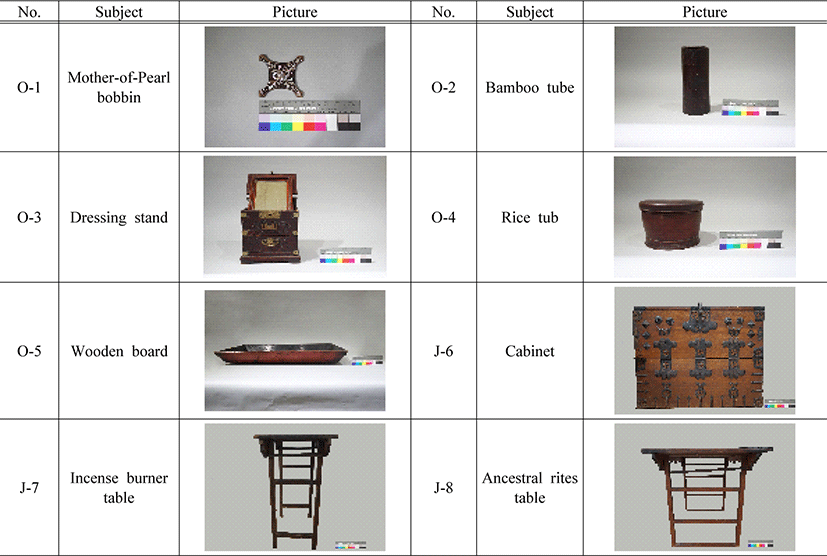
Optical microscope observations were conducted to determine material characteristics and manufacturing techniques (DM2700P, Leica, Wetzlar, Germany). Eight samples were collected from the lacquerware (Fig. 1). Samples were collected from the natural cracks of lacquerware using scalpels. The samples were fixed on a 15 mm silicone frame and cured with epoxy resin (Epofix, Struers, Ballerup, Denmark) for 24 h (Choi and Kim, 2018; Choi et al., 2022; Lee, 2017). The cured epoxy resin samples were cut using a micro-cutting machine (Minitom, Struers), and slices of 5 μm were crafted using polishing paper. Foreign substances were removed using an ultrasonic cleaner. A slice was placed on a sliding glass, and glycerin (50%, aq. soln.) was inserted and covered with a cover glass to create a preparat for the lacquer layer observation with transmitted, polarized, and reflected lights.
SEM-EDS analysis was carried out to analyze the components of pigments used in lacquerware. Samples were coated with gold. Data were collected using 20 kV of voltage and at 20 mm of working distance. Colored layers estimated to use pigments were analyzed. SEM (SU3800, Hitachi, Tokyo, Japan) was used to observe high magnification and EDS (Hitachi) was used to analyze the main components of colored layers.
FT-IR analysis was conducted to confirm the main components of lacquer. Data were collected in attenuated total reflection mode, 4 cm−1 of the resolution, 400–4,000 cm−1 of range, and 32 scans. Analyzed spectra were compared with the standard database and other preceding research data.
3. RESULTS and DISCUSSION
Through optical microscope observation, one lacquer layer was detected from a mother-of-pearl bobbin (O-1), bamboo tube (O-2), cabinet (J-6), and incense burner table (J-7; Fig. 2). The thickness of the lacquer layer was 40 μm in the mother-of-pearl bobbin, 30 μm in the bamboo tube, 20 μm in the cabinet, and 15 μm in the incense burner table. Crystal structures from wood were detected through polarized light observation. Mineral and pigment particles were not detected. Therefore, it is estimated that the mother-of-pearl bobbin, bamboo tube, cabinet, and incense burner table were made of wood and varnished only once.
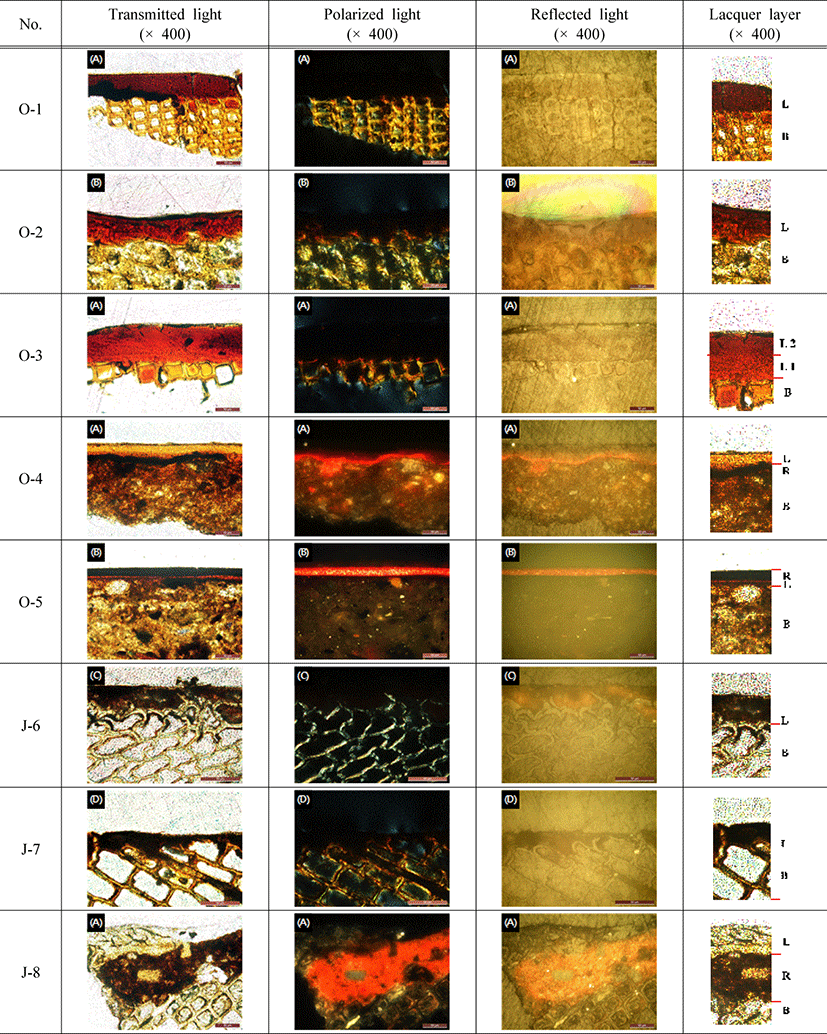
Two lacquer layers were observed in a dressing stand (O-3). The observed thickness of the dressing stand was 14 μm (first layer) and 66 μm (second layer) in a dressing stand (O-3). Crystal structures from wood were detected through polarized light observation. Mineral and pigment particles were not detected. Therefore, a dressing stand (O-3) was estimated to be made of wood and varnished twice.
Three lacquer layers were observed in the rice tub (O-4) and wooden board (O-5). The observed thickness of the rice tub (O-4) was 180 μm (base layer), 20 μm (red-colored layer), and 15 μm (lacquer layer). The observed thickness of the wooden board (O-5) was 320 μm (base layer), 10 μm (lacquer layer), and 15 μm (red-colored layer). Through polarized light observation, we detected mineral particles in the lacquer-clay mixed layer and red pigment particles in a red-colored layer. Through reflected light observation, we determined a red-colored layer. Therefore, it is estimated that the rice tub (O-4) was varnished on a wooden base in the consecutive order of the lacquer-clay layer, red-colored layer, and lacquer layer. A wooden board (O-5) was varnished on a wooden base in the consecutive order of the lacquer-clay layer, lacquer layer, and red-colored layer.
Two lacquer layers were observed in the ancestral rites table (J-8). The observed thickness of the ancestral rites table (J-8) was 80 μm (red-colored layer) and 50 μm (lacquer layer). Crystal particles of wood and red pigment particles were detected through polarized light observation. Furthermore, a red-colored layer was detected through reflected light observation. Therefore, the ancestral rites table (J-8) was varnished on a wooden base in consecutive order of the red-colored layer and lacquer layer.
According to the results of SEM-EDS, carbon and oxygen were detected from the lacquer layer of the mother-of-pearl bobbin (O-1), bamboo tub (O-2), and dressing stand (O-3; Fig. 3). A small amount of silicon and aluminum was also detected. Therefore, the lacquer layer was painted only with lacquer and without other inorganic pigment and lacquer clay.
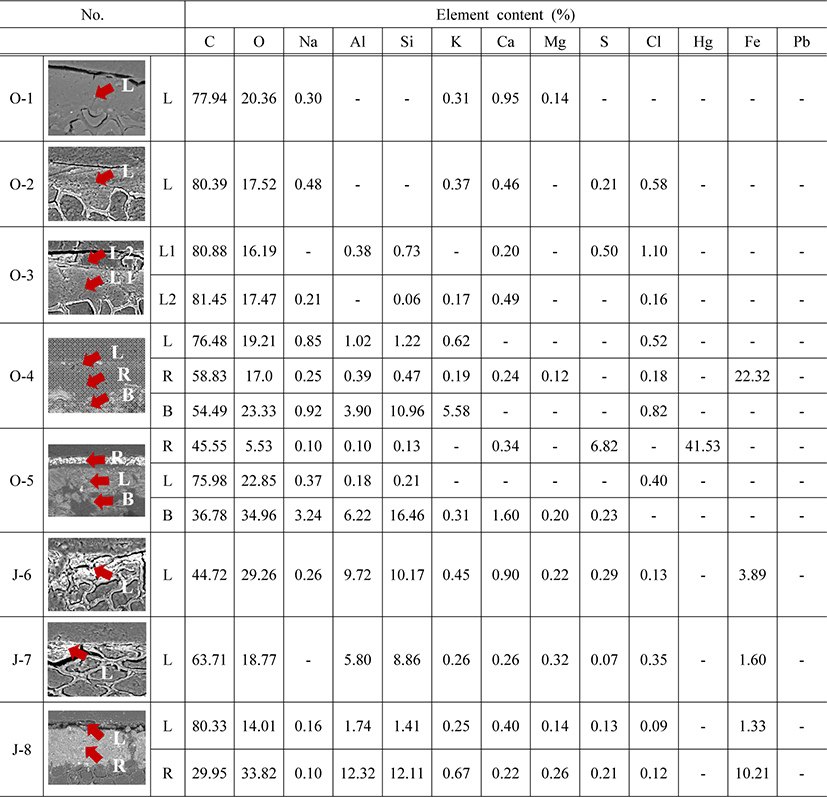
Carbon, oxygen, silicon, and aluminum were detected from the cabinet (J-6) and incense burner table (J-7). Therefore, it was assumed that mineral was used in the base and lacquer layer.
Carbon and oxygen were detected from the lacquer layer of the rice tub (O-4), wooden board (O-5), and ancestral rites table (J-8). Silicon and aluminum were detected from the base layer of the rice tub (O-4) and wooden board (O-5). Also, iron was detected from the red-colored layer of the rice tub (O-4) and ancestral rites table (J-8). Mercury and sulfur were detected from the red-colored layer of the wooden board (O-5).
Among red pigments with iron as a main component, red ocher and hematite were determined, whereas among those with mercury as a main component, cinnabar was identified. Therefore, it was assumed that the red-colored layers of the rice tub (O-4) and ancestral rites table (J-8) were made with red ocher or hematite and the red-colored layer of the wooden board (O-5) was made with cinnabar (National Research Institute of Cultural Heritage, 2020).
As shown in Fig. 4, the following results of FT-IR in the mother-of-pearl bobbin (O-1), bamboo tube (O-2), dressing stand (O-3), rice tub (O-4), wooden board (O-5), cabinet (J-6), and incense burner table (J-7) were detected: 3,600–3,200 cm−1 (-OH, hydroxyl group), 2,920–2,850 cm−1 (-CH3, = CH2, methylene group), 1,700 cm−1 (C = C, aromatic carbon coupling), 1,455 cm−1 (CH3, = CH2, bending vibration of methylene group), 1,000–1,150 cm−1 (–OH, hydroxyl group), 990–950 cm−1 (conjugated triene) and 720 cm−1 peaks (1,2,3-trisubstituted benzene). According to previous research and the FT-IR spectrum of lacquer built in this laboratory, as shown in Fig. 5, FT-IR peaks of urushiol polymer, which was the main component of lacquer, were detected as follows: 3,600–3,200 cm−1 (absorption peaks from hydroxyl group), 2,925 cm−1, 2,854 cm−1 (stretching vibration from the methylene group), 1,634 cm−1 (stretching vibration from C = C coupling), 1,456 cm−1 (banding vibration from the methylene group), 989 cm−1 (conjugated triene), 858 cm−1 (1,2,3,5-substituted benzene), 720 cm−1 (main characteristic of urushiol polymer from 1,2,3-trisubstituted benzene; Cho et al., 2010; Choi and Kim, 2018; Kim, 2007; Lee, 2021). Compared with the results of previous studies conducted on lacquer FT-IR analysis (Hwang et al., 2018; Kim et al., 2010; Lee and Han, 2017; Lim and Okada, 2018; Park et al., 2020a, 2021b), the peak height differed depending on the content of urushiol in the lacquer coating, drying environment, and UV deterioration. Due to inorganic components included in the lower layer of the lacquer coating film and some oxidation products, different spectra were observed in the fingerprint area of 1,000 cm−1 or less. As a result of checking the overall spectrum shown in Fig. 6, in the paints used in O-1–5 and J-6–7, almost the same spectrum as the fingerprint spectrum of the lacquer coating film was observed. Therefore, it was determined that the paints used in O-1–5 and J-6–7 were layered with lacquer.
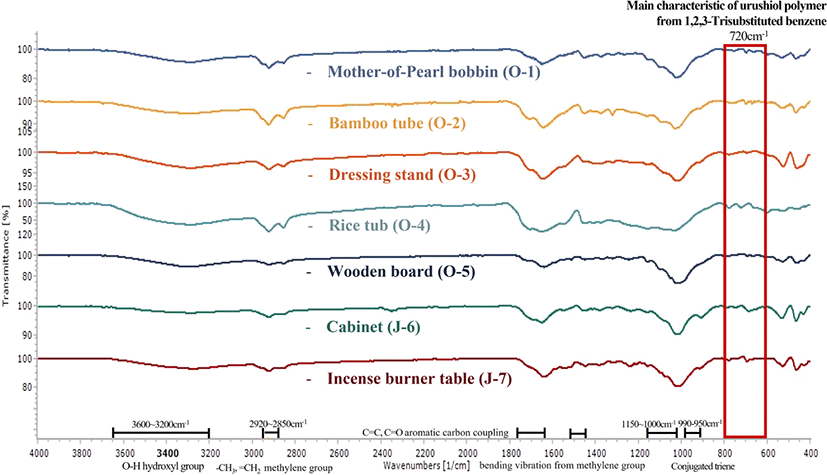
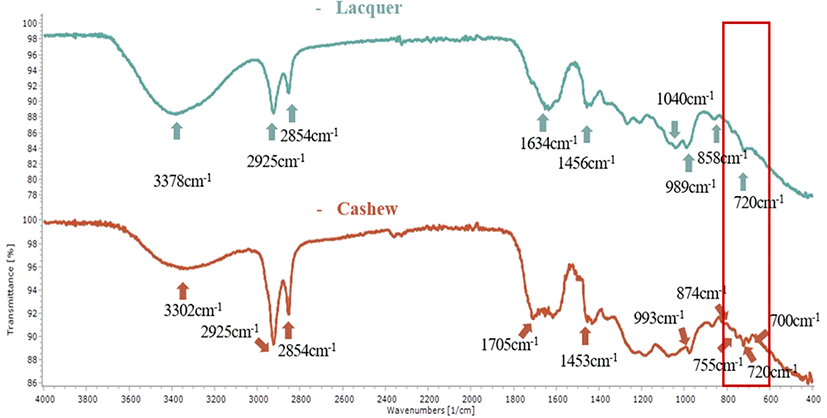

As shown in Fig. 7, FT-IR peaks were detected from the ancestral rites table (J-8) as 3,560–3,200 cm−1 (-OH, hydroxyl group), 2,920–2,850 cm−1 (-CH3, = CH2, methylene group), 1,750–1,600 cm−1 (stretching vibration from C = C and C = O coupling), 1,450 cm−1 (bending vibration from the methylene group), broad band of 1,150–1,000 cm−1 (hydroxyl group), 950–900 cm−1 (conjugated triene), 874 cm−1 (1,2,3,5-substituted benzene), and 755 cm−1, 720 cm−1, 700 cm−1 (1,3-disubstituted benzene). This demonstrates a spectrum pattern similar to that of the lacquer, but sharp peaks are observed in three areas such as 755 cm−1, 720 cm−1, and 700 cm−1 in the fingerprint area of 1,000 cm−1 or less. As shown in Fig. 8, when checking the FT-IR spectrum of lacquer and cashew shell nut liquid built in this laboratory, a distinctive difference was observed. This was concluded to be a characteristic of cardanol polymer, the main component of cashew shell nut liquid. Therefore, it was estimated that the paint used for the ancestral rites table (J-8) was layered with cashew shell nut liquid (Choi and Kim, 2018; Lee, 2021).
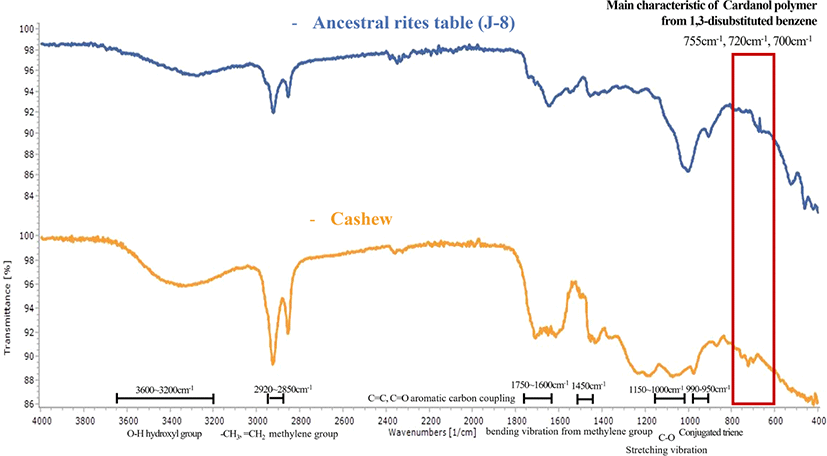

4. CONCLUSIONS
In this study, scientific analysis was conducted on eight objects of wooden lacquerware estimated to be made during the late Joseon Dynasty. As result, lacquer was identified in seven objects, whereas cashew shell nut liquid was identified in one object. Cashew shell nut liquid was investigated by Japanese cooperation in 1939. It was used as a varnish for wooden objects owing to its good thermal resistance, oil-proofing, and chemical resistance in modern times (Choi and Kim, 2018; Lee, 2021; Tetsuo, 2007). Therefore, it was expected that the ancestral rites table would be repainted with cashew shell nut liquid in modern times. Also, most of the objects have 1–2 lacquer layers, and partial red-colored layers were identified.
The research results showed that the lacquerware technique was similar to that of the ancient time during the Goryeo Dynasty; however, it was simplified as it was varnished directly on wooden objects (Lee and Okada, 2016; Lim and Okada, 2018; Yi, 2010; Yi et al., 2014, 2000).
Compared to the early Joseon Dynasty during which lacquer production was state-led, the collapse of the state-led handicraft industry, technical regression, and the development of currency during the late Joseon Dynasty led to a rise of independent and full-time craftsmen and eventually, the emergence of the private handicraft industry (Kim, 2018). Indigenous design symbols reflecting folk religion were made as various wooden lacquerware (Sin, 2013).
Therefore, due to social change and technical regression, lacquerware techniques were simplified; however, the basic techniques of composing lacquer clay and pigment when producing lacquerware were maintained.
Wooden lacquerware manufacturing techniques during the late Joseon Dynasty were investigated through the collection of the Onyang Folk Museum and Jeju Haenyeo Museum. These databases can be utilized as a reference for the conservation and restoration of lacquerware manufacturing techniques during the late Joseon Dynasty (Han and Lee, 2021a, 2021b). Furthermore, this was expected to complement the lack of analytical data on lacquerware in the late Joseon Dynasty.
